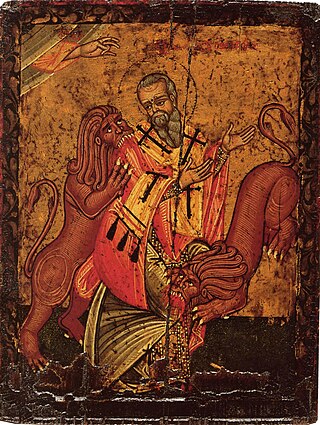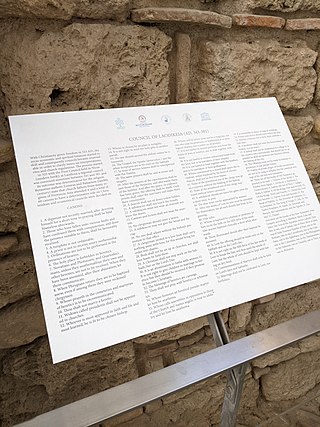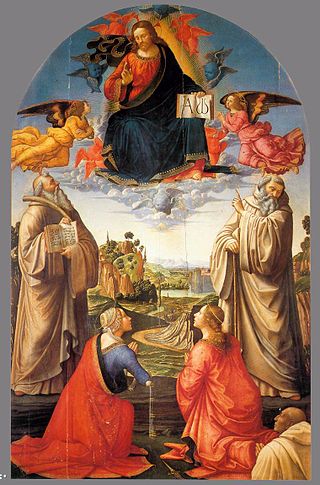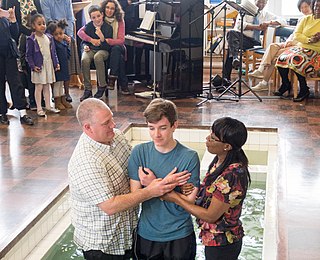Related Research Articles

The Athanasian Creed—also called the Quicunque Vult, which is both its Latin name and its opening words, meaning "Whosoever wishes"—is a Christian statement of belief focused on Trinitarian doctrine and Christology. Used by Christian churches since the early sixth century, it was the first creed to explicitly state the equality of the three hypostases of the Trinity. It differs from the Nicene-Constantinopolitan Creed and the Apostles' Creed in that it includes anathemas condemning those who disagree with its statements, as does the original Nicene Creed.
The Apostles' Creed, sometimes titled the Apostolic Creed or the Symbol of the Apostles, is a Christian creed or "symbol of faith".
The Chalcedonian Definition is the declaration of the dyophysitism of Christ's nature, adopted at the Council of Chalcedon in AD 451. Chalcedon was an early centre of Christianity located in Asia Minor. The council was the fourth of the ecumenical councils that are accepted by Chalcedonian churches which include the Catholic and Orthodox churches.

Cyril of Jerusalem was a theologian of the Early Church. About the end of AD 350, he succeeded Maximus as Bishop of Jerusalem, but was exiled on more than one occasion due to the enmity of Acacius of Caesarea, and the policies of various emperors. Cyril left important writings documenting the instruction of catechumens and the order of the Liturgy in his day.

The word catholic comes from the Greek phrase καθόλου 'on the whole, according to the whole, in general', and is a combination of the Greek words κατά 'about' and ὅλος 'whole'. The first known use of "Catholic" was by the church father Saint Ignatius of Antioch in his Letter to the Smyrnaeans. In the context of Christian ecclesiology, it has a rich history and several usages.

The First Council of Nicaea was a council of Christian bishops convened in the Bithynian city of Nicaea by the Roman Emperor Constantine I. The Council of Nicaea met from May until the end of July 325.
The Nicene Creed, also called the Creed of Constantinople, is the defining statement of belief of Nicene Christianity and in those Christian denominations that adhere to it.

Philip Schaff was a Swiss-born, German-educated Protestant theologian and ecclesiastical historian, who spent most of his adult life living and teaching in the United States.

According to Christian tradition, the True Cross is the cross on which Jesus of Nazareth was crucified.

A catechism is a summary or exposition of doctrine and serves as a learning introduction to the Sacraments traditionally used in catechesis, or Christian religious teaching of children and adult converts. Catechisms are doctrinal manuals – often in the form of questions followed by answers to be memorised – a format that has been used in non-religious or secular contexts as well. According to Norman DeWitt, the early Christians appropriated this practice from the Epicureans, a school whose founder Epicurus had instructed to keep summaries of the teachings for easy learning. The term catechumen refers to the designated recipient of the catechetical work or instruction. In the Catholic Church, catechumens are those who are preparing to receive the Sacrament of Baptism. Traditionally, they would be placed separately during Holy Mass from those who had been baptized, and would be dismissed from the liturgical assembly before the Profession of Faith and General Intercessions.
The East–West Schism, also known as the Great Schism or the Schism of 1054, is the break of communion between the Catholic Church and the Eastern Orthodox Church since 1054. A series of ecclesiastical differences and theological disputes between the Greek East and Latin West preceded the formal split that occurred in 1054. Prominent among these were the procession of the Holy Spirit, whether leavened or unleavened bread should be used in the Eucharist, iconoclasm, the coronation of Charlemagne as Emperor of the Romans in 800, the Pope's claim to universal jurisdiction, and the place of the See of Constantinople in relation to the pentarchy.

The Council of Laodicea was a regional Christian synod of approximately thirty clerics from Asia Minor which assembled about 363–364 in Laodicea, Phrygia Pacatiana.

God the Son is the second Person of the Trinity in Christian theology. According to Christian doctrine, God the Son, in the form of Jesus Christ, is the incarnation of the eternal, pre-existent divine Logos through whom all things were created. Although the precise term "God the Son" does not appear in the Bible, it serves as a theological designation expressing the understanding of Jesus as a part of the Trinity, distinct yet united in essence with God the Father and God the Holy Spirit.

The reformed confessions of faith are the confessional documents of various Reformed churches. These express the doctrinal views of the churches adopting the confession. Confessions play a crucial part in the theological identity of reformed churches, either as standards to which ministers must subscribe, or more generally as accurate descriptions of their faith. Most confessions date to the 16th and 17th century.
The Synod of Jerusalem was an Eastern Orthodox synod held in 1672. It is also called the Synod of Bethlehem.
In Christian theology, baptism of blood or baptism by blood, also called martyred baptism, is a doctrine which holds that a Christian is able to attain through martyrdom the grace of justification normally attained through baptism by water, without needing to receive baptism by water.

Catechesis is basic Christian religious education of children and adults, often from a catechism book. It started as education of converts to Christianity, but as the religion became institutionalized, catechesis was used for education of members who had been baptized as infants. As defined in the Catechism of the Catholic Church, paragraph 5 :
Catechesis is an education in the faith of children, young people and adults which includes especially the teaching of Christian doctrine imparted, generally speaking, in an organic and systematic way, with a view to initiating the hearers into the fullness of Christian life.

Coptic history is the part of the history of Egypt that begins with the introduction of Christianity in Egypt in the 1st century AD during the Roman period, and covers the history of the Copts to the present day. Many of the historic items related to Coptic Christianity are on display in many museums around the world and a large number is in the Coptic Museum in Coptic Cairo.

Believer's baptism or adult baptism is the practice of baptizing those who are able to make a conscious profession of faith, as contrasted to the practice of baptizing infants. Credobaptists believe that infants incapable of consciously believing should not be baptized.

The expression minor exorcism can be used in a technical sense or a general sense. The general sense indicates any exorcism which is not a solemn exorcism of a person believed to be possessed, including various forms of deliverance ministry. This article deals only with the technical sense which specifically refers to certain prayers used with persons preparing to become baptised members of the churches which makes use of such rites. These prayers request God's assistance so that the person to be baptised will be kept safe from the power of Satan or protected in a more general way from temptation.
References
- ↑ Philip Schaff. "2". Creeds of Christendom, with a History and Critical notes. Volume I. The History of Creeds. Vol. 1. Retrieved 2011-12-21.
- ↑ "Catechetical Lecture 19". New Advent. Retrieved 2011-12-21.